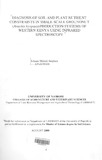Diagnosis of soil and plant nutrient constraints in small-scale ground nut (Arachis Hyopaea) production systems of Western Kenya using infrared spectroscopy
Abstract
Soil fertility degradation is a major problem in Africa leading to food insecurity,
ecosystem degradation and poverty. Nutrient depletion and disease epidemics have
contributed to a decline in groundnut yields of 25% in the past decade in Sub-Saharan
Africa. Studies have demonstrated that infrared spectroscopy (IR) may permit rapid and cost
effective analysis of tropical soil nutrients. Trial and error and field observations methods
used by farmers are inefficient and have led to inappropriate soil nutrient management
strategies and options in small-scale crop production systems.
This study sought to survey the prevalence of soil nutrient constraints in the smallscale
groundnut production systems of western Kenya and to explore the potential of IR as a
diagnostic tool for soil nutrient constraints. The soil properties examined were soil pHw, total
carbon (TC), total nitrogen (TN), extractable phosphorus (Ext. P), exchangeable potassium
(K), exchangeable calcium (Ca), exchangeable magnesium (Mg) and particle size
distribution (PSA) while for plant macronutrients, nitrogen (N), phosphorus (P) potassium
(K) were examined and micronutrients, copper (Cu), zinc (Zn) iron (Fe) and manganese
(Mn). Reference data that were used for developing calibration models were analyzed using
standard laboratory methods widely used for tropical soils and plants. Soil pH was
determined using an electrode pH meter for saturated soil paste. Exchangeable Ca and Mg
were determined by the use of the atomic absorption spectrometry (AAS). The Olsen method
was used to colorimetrically determine Ext.P. Total carbon (TC) and (TN) were determined
using the C: N analyzer and particle size analysis (PSA) was determined using the
hydrometer method. The plant macronutrients N, P, K, were determined by Kjeldahl
distillation method, while the micro nutrients Cu, Zn, Mn and Fe were analyzed by ashing
prior to determination by AAS. The reference data were then calibrated to soil and plant
reflectance. Stable calibration models were developed for several key soil nutrients using the
near-infrared (NIR) and mid-infrared (MIR) diffuse reflectance spectroscopy and partial
least square regression (PLSR) statistical analysis. Robust calibration model were obtained;
soil pHw (r2=0.85), TC (r2=0.98), TN (;=0.97), Ca (;=0.95) and Mg (r2=0.94), sand
r2=0.85) silt ;=0.82 and clay r2 =0.81 for the MIR spectral region. Extractable P and Exch.
K had weak calibration models with r2 values of 0.66 and 0.50 for MIR respectively, 0.50
and 0.32 for NIR respectively. Similar results were obtained for above-ground groundnut
biomass although P and K yielded good calibration models. Attenuated total reflectance
(ATR) yielded robust calibration for TN from saturated soil pastes with r2 values of 0.94.
The study demonstrated the utility and potential of IR spectroscopy as a diagnostic
screening tool for soil and plant nutrition in small-scale production systems. Principal
component analysis (PCA) was used to summarize the variability in soil properties. Soil
fertility indicators (SFIs) that were developed from the principal components were then used
to evaluate soil nutrient levels based on critical nutrient levels. The SFIs were successfully
calibrated to soil reflectance measured in the laboratory with cross validated; values of 0.97
and 0.87 for MIR and NIR, respectively. Groundnut farms were critically deficient in
principal nutrients; TN (75%), Ext.P (65%), and Exch. Ca (100%) which fell below the
critical nutrient levels based on soil and plant MIR spectral predictions. Replenishment of
these principle nutrients is crucial for sustainable groundnut productivity in western Kenya.
Citation
Ichami, S.M(2008). Diagnosis of soil and plant nutrient constraints in small-scale ground nut (Arachis Hyopaea) production systems of Western Kenya using infrared spectroscopySponsorhip
University of NairobiPublisher
Department of Land Resource Management and Agricultural Technology, University of Nairobi
Subject
DiagnosisSoil and plant nutrient
Ground nut (Arachis Hyopaea)
Production
Western Kenya
Infrared spectroscopy
Description
Msc - Thesis

